The Ratio of the Land Consumption Rate to the Population Growth Rate: A Framework for the Achievement of the Spatiotemporal Pattern in Poland and Lithuania
Abstract
:1. Introduction
- –
- The land use efficiency in Poland and Lithuania, including spatial and statistical characteristics;
- –
- The spatial pattern of the land cover ratio and the population growth ratio;
- –
- The relationship between land cover change and population change;
- –
- The influence of the uncertainty of remotely sensed source data on the SDG 11.3. 1 values.
2. Materials and Methods
2.1. Study Area
2.2. Data Use Description
2.3. Applied Method
2.3.1. Workflow
2.3.2. LCR, PGR, and LCRPGR Index Calculations
2.3.3. Spatial Autocorrelation
3. Results
3.1. Population Growth Rate
3.2. Land Cover Ratio
3.3. LCRPGR Visualization and Analysis
4. Discussion
4.1. Brief Comparative Analysis between Poland and Lithuania
4.2. Concise References to LCRPGR Studies
4.3. Semantic Uncertainty
4.4. Land Use Efficiency Interpretation Problems
4.5. Cartographic Presentation Challenges
5. Conclusions
Supplementary Materials
Author Contributions
Funding
Data Availability Statement
Acknowledgments
Conflicts of Interest
References
- Scott, J.; Marshall, G. A Dictionary of Sociology; Oxford University Press: Oxford, UK, 2009; ISBN 978-0-19-953300-8. [Google Scholar]
- Berg, L.; European Coordination Centre for Research and Documentation in Social Sciences. Urban Europe, a Study of Growth and Decline; Pergamon Press: Oxford, NY, USA, 1982. [Google Scholar]
- Champion, T. Urbanization, Suburbanization, Counterurbanization and Reurbanization. In Handbook of Urban Studies; SAGE Publications Ltd.: London, UK, 2001; pp. 143–161. ISBN 978-0-8039-7695-5. [Google Scholar]
- Schmid, C.; Karaman, O.; Hanakata, N.C.; Kallenberger, P.; Kockelkorn, A.; Sawyer, L.; Streule, M.; Wong, K.P. Towards a New Vocabulary of Urbanisation Processes: A Comparative Approach. Urban Stud. 2018, 55, 19–52. [Google Scholar] [CrossRef]
- Dieleman, F.; Wegener, M. Compact City and Urban Sprawl. Built. Environ. 2004, 30, 308–323. [Google Scholar] [CrossRef] [Green Version]
- Wegener, M.; Fuerst, F. Land-Use Transport Interaction: State of the Art. 2004. Available online: http://dx.doi.org/10.2139/ssrn.1434678 (accessed on 20 September 2021).
- Kocur-Bera, K.; Pszenny, A. Conversion of Agricultural Land for Urbanization Purposes: A Case Study of the Suburbs of the Capital of Warmia and Mazury, Poland. Remote Sens. 2020, 12, 2325. [Google Scholar] [CrossRef]
- Liu, J.; Kuang, W.; Zhang, Z.; Xu, X.; Qin, Y.; Ning, J.; Zhou, W.; Zhang, S.; Li, R.; Yan, C.; et al. Spatiotemporal Characteristics, Patterns, and Causes of Land-Use Changes in China since the Late 1980s. J. Geogr. Sci. 2014, 24, 195–210. [Google Scholar] [CrossRef]
- Mudau, N.; Mwaniki, D.; Tsoeleng, L.; Mashalane, M.; Beguy, D.; Ndugwa, R. Assessment of SDG Indicator 11.3.1 and Urban Growth Trends of Major and Small Cities in South Africa. Sustainability 2020, 12, 7063. [Google Scholar] [CrossRef]
- Paganini, M.; Petiteville, I. Satellite Earth Observations in Support of the Sustainable Development Goals|ALNAP; CEOS–ESA: Roma, Italy, 2018.
- Anderson, K.; Ryan, B.; Sonntag, W.; Kavvada, A.; Friedl, L. Earth Observation in Service of the 2030 Agenda for Sustainable Development. Geo-Spat. Inf. Sci. 2017, 20, 77–96. [Google Scholar] [CrossRef]
- Schiavina, M.; Florczyk, A.J.; MacManus, K.; Pesaresi, M.; Corbane, C.; Borkovska, O.; Mills, J.; Pistolesi, L.; Squires, J.; Sliuzas, R. Enhanced Data and Methods for Improving Open and Free Global Population Grids: Putting ‘Leaving No One behind’ into Practice. Int. J. Digit. Earth 2020, 13, 61–77. [Google Scholar] [CrossRef] [Green Version]
- Belward, A.S.; Skøien, J.O. Who Launched What, When and Why; Trends in Global Land-Cover Observation Capacity from Civilian Earth Observation Satellites. ISPRS J. Photogramm. Remote Sens. 2015, 103, 115–128. [Google Scholar] [CrossRef]
- Global Human Settlement—GHSL Homepage—European Commission. Available online: https://ghsl.jrc.ec.europa.eu/ (accessed on 20 September 2021).
- Shlomo, A.; Blei, A.M.; Jason, P. Atlas of Urban Expansion—2016 Edition. Available online: https://www.lincolninst.edu/publications/other/atlas-urban-expansion-2016-edition (accessed on 20 September 2021).
- Esch, T.; Heldens, W.; Hirner, A.; Keil, M.; Marconcini, M.; Roth, A.; Zeidler, J.; Dech, S.; Strano, E. Breaking New Ground in Mapping Human Settlements from Space—The Global Urban Footprint. ISPRS J. Photogramm. Remote Sens. 2017, 134, 30–42. [Google Scholar] [CrossRef] [Green Version]
- Urban Atlas—Copernicus Land Monitoring Service. Available online: https://land.copernicus.eu/local/urban-atlas (accessed on 20 September 2021).
- Schiavina, M.; Melchiorri, M.; Corbane, C.; Florczyk, A.J.; Freire, S.; Pesaresi, M.; Kemper, T. Multi-Scale Estimation of Land Use Efficiency (SDG 11.3.1) across 25 Years Using Global Open and Free Data. Sustainability 2019, 11, 5674. [Google Scholar] [CrossRef] [Green Version]
- Zhou, M.; Lu, L.; Guo, H.; Weng, Q.; Cao, S.; Zhang, S.; Li, Q. Urban Sprawl and Changes in Land-Use Efficiency in the Beijing–Tianjin–Hebei Region, China from 2000 to 2020: A Spatiotemporal Analysis Using Earth Observation Data. Remote Sens. 2021, 13, 2850. [Google Scholar] [CrossRef]
- Wang, Y.; Huang, C.; Feng, Y.; Zhao, M.; Gu, J. Using Earth Observation for Monitoring SDG 11.3.1-Ratio of Land Consumption Rate to Population Growth Rate in Mainland China. Remote Sens. 2020, 12, 357. [Google Scholar] [CrossRef] [Green Version]
- Nicolau, R.; David, J.; Caetano, M.; Pereira, J.M.C. Ratio of Land Consumption Rate to Population Growth Rate—Analysis of Different Formulations Applied to Mainland Portugal. ISPRS Int. J. Geo-Inf. 2019, 8, 10. [Google Scholar] [CrossRef] [Green Version]
- Aquilino, M.; Adamo, M.; Blonda, P.; Barbanente, A.; Tarantino, C. Improvement of a Dasymetric Method for Implementing Sustainable Development Goal 11 Indicators at an Intra-Urban Scale. Remote Sens. 2021, 13, 2835. [Google Scholar] [CrossRef]
- Sharma, L.; Pandey, P.C.; Nathawat, M.S. Assessment of Land Consumption Rate with Urban Dynamics Change Using Geospatial Techniques. J. Land Use Sci. 2012, 7, 135–148. [Google Scholar] [CrossRef]
- Oyugi, M.; Odenyo, V.; Karanja, F. The Implications of Land Use and Land Cover Dynamics on the Environmental Quality of Nairobi City, Kenya. Am. J. Geogr. Inf. Syst. 2017, 6, 111–127. [Google Scholar]
- Wiatkowska, B.; Słodczyk, J.; Stokowska, A. Spatial-Temporal Land Use and Land Cover Changes in Urban Areas Using Remote Sensing Images and GIS Analysis: The Case Study of Opole, Poland. Geosciences 2021, 11, 312. [Google Scholar] [CrossRef]
- Wardrop, N.A.; Jochem, W.C.; Bird, T.J.; Chamberlain, H.R.; Clarke, D.; Kerr, D.; Bengtsson, L.; Juran, S.; Seaman, V.; Tatem, A.J. Spatially Disaggregated Population Estimates in the Absence of National Population and Housing Census Data. Proc. Natl. Acad. Sci. USA 2018, 115, 3529–3537. [Google Scholar] [CrossRef] [Green Version]
- Yuan, Y.; Smith, R.M.; Limp, W.F. Remodeling Census Population with Spatial Information from Landsat TM Imagery. Comput. Environ. Urban Syst. 1997, 21, 245–258. [Google Scholar] [CrossRef]
- Chu, H.-J.; Yang, C.-H.; Chou, C.C. Adaptive Non-Negative Geographically Weighted Regression for Population Density Estimation Based on Nighttime Light. ISPRS Int. J. Geo-Inf. 2019, 8, 26. [Google Scholar] [CrossRef] [Green Version]
- Liu, X.; Keith, C.; Herold, M. Population Density and Image Texture: A Comparison Study. Photogramm. Eng. Remote Sens. 2006, 72, 187–196. [Google Scholar] [CrossRef] [Green Version]
- Leyk, S.; Gaughan, A.E.; Adamo, S.B.; de Sherbinin, A.; Balk, D.; Freire, S.; Rose, A.; Stevens, F.R.; Blankespoor, B.; Frye, C.; et al. The Spatial Allocation of Population: A Review of Large-Scale Gridded Population Data Products and Their Fitness for Use. Earth Syst. Sci. Data 2019, 11, 1385–1409. [Google Scholar] [CrossRef] [Green Version]
- UNSTAS. The Sustainable Development Goals 2017. Available online: https://unstats.un.org/sdgs/report/2017/ (accessed on 21 October 2021).
- Philip, E. Coupling Sustainable Development Goal 11.3.1 with Current Planning Tools: City of Hamilton, Canada. Hydrol. Sci. J. 2021, 66, 1124–1131. [Google Scholar] [CrossRef]
- Jiang, H.; Sun, Z.; Guo, H.; Weng, Q.; Du, W.; Xing, Q.; Cai, G. An Assessment of Urbanization Sustainability in China between 1990 and 2015 Using Land Use Efficiency Indicators. NPJ Urban Sustain. 2021, 1, 1–13. [Google Scholar] [CrossRef]
- Shelestov, A.; Kussul, N.; Yailymov, B.; Shumilo, L.; Bilokonska, Y. Assessment of Land Consumption for SDG Indicator 11.3.1 Using Global and Local Built-Up Area Maps. In Proceedings of the IGARSS 2020—2020 IEEE International Geoscience and Remote Sensing Symposium, Waikoloa, HI, USA, 26 September–2 October 2020; pp. 4971–4974. [Google Scholar]
- Melchiorri, M.; Pesaresi, M.; Florczyk, A.J.; Corbane, C.; Kemper, T. Principles and Applications of the Global Human Settlement Layer as Baseline for the Land Use Efficiency Indicator—SDG 11.3.1. ISPRS Int. J. Geo-Inf. 2019, 8, 96. [Google Scholar] [CrossRef] [Green Version]
- Lisiński, M.; Augustinaitis, A.; Nazarko, L.; Ratajczak, S. Evaluation of Dynamics of Economic Development in Polish and Lithuanian Regions. J. Bus. Econ. Manag. 2020, 21, 1093–1110. [Google Scholar] [CrossRef]
- UNDP Human Development Report 2019, beyond Income, beyond Averages, beyond Today: Inequalities in Human Development in the 21st Century. 2019 by the Unit-Ed Nations Development Programme 1 UN Plaza, New York, NY, USA. Available online: http://hdr.undp.org/en/content/human-development-report-2019 (accessed on 22 October 2021).
- UN World Population Prospects—Population Division—United Nations. Available online: https://population.un.org/ (accessed on 16 August 2021).
- Komornicki, T.; Korcelli, P.; Siłka, P.; Śleszyński, P.; Świątek, D. Powiązania Funkcjonalne Pomiędzy Polskimi Metropoliami; Wydawnictwo Akademickie Sedno: Warsaw, Poland, 2013. [Google Scholar]
- Calka, B.; Bielecka, E. Reliability Analysis of LandScan Gridded Population Data. The Case Study of Poland. ISPRS Int. J. Geo-Inf. 2019, 8, 222. [Google Scholar] [CrossRef] [Green Version]
- UNSD Document. Available online: https://unstats.un.org/unsd/dnss/docViewer.aspx?docID=615#start (accessed on 16 August 2021).
- Freire, S.; Doxsey-Whitfield, E.; MacManus, K.; Mills, J.; Pesaresi, M. Development of new open and free multi-temporal global population grids at 250-m resolution. In Proceedings of the 19th AGILE Conference on Geographic Information Science, Helsinki, Geographic and Temporal Access to Basic Banking Services Offered through Post Offices in Wales, Helsinki, Finland, 14–17 June 2016; Available online: https://www.researchgate.net/publication/353794231_Geographic_and_Temporal_Access_to_Basic_Banking_Services_Offered_through_Post_Offices_in_Wales (accessed on 2 September 2021).
- Calka, B.; Bielecka, E. GHS-POP Accuracy Assessment: Poland and Portugal Case Study. Remote Sens. 2020, 12, 1105. [Google Scholar] [CrossRef] [Green Version]
- Florczyk, A.J.; Corbane, C.; Ehrlich, D.; Freire, S.; Kemper, T.; Maffenini, L.; Melchiorri, M.; Pesaresi, M.; Politis, P.; Schiavina, M.; et al. GHSL Data Package 2019: Public Release GHS P2019; Publications Office of the European Union: Luxembourg, 2019; ISBN 978-92-76-13186-1.
- Palacios-Lopez, D.; Bachofer, F.; Esch, T.; Heldens, W.; Hirner, A.; Marconcini, M.; Sorichetta, A.; Zeidler, J.; Kuenzer, C.; Dech, S.; et al. New Perspectives for Mapping Global Population Distribution Using World Settlement Footprint Products. Sustainability 2019, 11, 6056. [Google Scholar] [CrossRef] [Green Version]
- Gutman, G.; Huang, C.; Chander, G.; Noojipady, P.; Masek, J.G. Assessment of the NASA–USGS Global Land Survey (GLS) Datasets. Remote Sens. Environ. 2013, 134, 249–265. [Google Scholar] [CrossRef]
- Corbane, C.; Pesaresi, M.; Politis, P.; Syrris, V.; Florczyk, A.J.; Soille, P.; Maffenini, L.; Burger, A.; Vasilev, V.; Rodriguez, D.; et al. Big Earth Data Analytics on Sentinel-1 and Landsat Imagery in Support to Global Human Settlements Mapping. Big Earth Data 2017, 1, 118–144. [Google Scholar] [CrossRef] [Green Version]
- Bossard, M.; Feranec, J.; Otahel, J. CORINE Land Cover Technical Guide—Addendum 2000. Available online: https://www.semanticscholar.org/paper/CORINE-land-cover-technical-guide-Addendum-2000-Bossard-Feranec/6c86b8258ab2afa3bf4ce31aefc412620dd5defd (accessed on 18 August 2021).
- The Thematic Accuracy of Corine Land Cover 2000—Assessment Using LUCAS—European Environment Agency. Available online: https://www.eea.europa.eu/publications/technical_report_2006_7 (accessed on 27 August 2021).
- Gotlib, D.; Baranowski, M.; Olszewski, R. Cechy Modelowania Kartograficznego w Kontekście Współczesnej Definicji Mapy. Polish Cartogr. Rev. 2016, 48, 91–100. [Google Scholar]
- Korycka-Skorupa, J.; Gołębiowska, I.M. Numbers on Thematic Maps: Helpful Simplicity or Too Raw to Be Useful for Map Reading? ISPRS Int. J. Geo-Inf. 2020, 9, 415. [Google Scholar] [CrossRef]
- Tomlin, C.D. GIS and Cartographic Modeling; Esri Press: Redlands, CA, USA, 2012; ISBN 978-158-948-309-5. [Google Scholar]
- Nieves, J.J.; Stevens, F.R.; Gaughan, A.E.; Linard, C.; Sorichetta, A.; Hornby, G.; Patel, N.N.; Tatem, A.J. Examining the Correlates and Drivers of Human Population Distributions across Low- and Middle-Income Countries. J. R. Soc. Interface 2017, 14, 20170401. [Google Scholar] [CrossRef] [Green Version]
- Jedwab, R.; Christiaensen, L.; Gindelsky, M. Demography, Urbanization and Development: Rural Push, Urban Pull And…urban Push? J. Urban Econ. 2017, 98, 6–16. [Google Scholar] [CrossRef] [Green Version]
- Venables, A.J. Breaking into Tradables: Urban Form and Urban Function in a Developing City. J. Urban Econ. 2017, 98, 88–97. [Google Scholar] [CrossRef] [Green Version]
- Seo, S. A Review and Comparison of Methods for Detecting Outliers in Univariate Data Sets. Master’s Thesis, University of Pittsburghs, Pittsburgh, PA, USA, 2006. [Google Scholar]
- Calka, B. Estimating Residential Property Values on the Basis of Clustering and Geostatistics. Geosciences 2019, 9, 143. [Google Scholar] [CrossRef] [Green Version]
- Bielecka, E.; Pokonieczny, K.; Borkowska, S. GIScience Theory Based Assessment of Spatial Disparity of Geodetic Control Points Location. ISPRS Int. J. Geo-Inf. 2020, 9, 148. [Google Scholar] [CrossRef] [Green Version]
- Pokonieczny, K.; Calka, B.; Bielecka, E.; Kaminski, P. Modeling Spatial Relationships between Geodetic Control Points and Land Use with Regards to Polish Regulation. In Proceedings of the 2016 Baltic Geodetic Congress (BGC Geomatics), Gdansk, Poland, 2–4 June 2016; IEEE: Piscataway, NJ, USA, 2016; pp. 176–180. [Google Scholar]
- Songchitruksa, P.; Zeng, X. Getis–Ord Spatial Statistics to Identify Hot Spots by Using Incident Management Data. Transp. Res. Rec. J. Transp. Res. Board 2010, 2165, 42–51. [Google Scholar] [CrossRef]
- Getis, A.; Ord, J.K. The Analysis of Spatial Association by Use of Distance Statistics. Geogr. Anal. 1992, 24, 189–206. [Google Scholar] [CrossRef]
- Lu, P.; Bai, S.; Tofani, V.; Casagli, N. Landslides Detection through Optimized Hot Spot Analysis on Persistent Scatterers and Distributed Scatterers. ISPRS J. Photogramm. Remote Sens. 2019, 156, 147–159. [Google Scholar] [CrossRef]
- Smith, M.J.D.; Goodchild, M.F.; Longley, P. Geospatial Analysis: A Comprehensive Guide to Principles, Techniques and Software Tools, 6th ed.; Troubador Publishing Ltd.: Leicester, UK, 2018; pp. 295–315. [Google Scholar]
- Maleta, M.; Calka, B. Examining Spatial Autocorrelation of Real Estate Features Using Moran Statistics. In Proceedings of the 15th International Multidisciplinary Scientific Geoconference SGEM 2015, Albena, Bulgaria, 18–24 June 2015; Book 2. Volume 2, pp. 841–848. [Google Scholar]
- Ghazaryan, G.; Rienow, A.; Oldenburg, C.; Thonfeld, F.; Trampnau, B.; Sticksel, S.; Jürgens, C. Monitoring of Urban Sprawl and Densification Processes in Western Germany in the Light of SDG Indicator 11.3.1 Based on an Automated Retrospective Classification Approach. Remote Sens. 2021, 13, 1694. [Google Scholar] [CrossRef]
- Indicateurs Territoriaux de Développement Durable|Insee. Available online: https://www.insee.fr/fr/statistiques/4505239#dictionnaire (accessed on 24 September 2021).
- Song, Y.; Huang, B.; Cai, J.; Chen, B. Dynamic Assessments of Population Exposure to Urban Greenspace Using Multi-Source Big Data. Sci. Total Environ. 2018, 634, 1315–1325. [Google Scholar] [CrossRef]
- Aune-Lundberg, L.; Strand, G.-H. The Content and Accuracy of the CORINE Land Cover Dataset for Norway. Int. J. Appl. Earth Obs. Geoinf. 2021, 96, 102266. [Google Scholar] [CrossRef]
- Congalton, R.G. A Review of Assessing the Accuracy of Classifications of Remotely Sensed Data. Remote Sens. Environ. 1991, 37, 35–46. [Google Scholar] [CrossRef]
- Corbane, C.; Pesaresi, M.; Kemper, T.; Politis, P.; Florczyk, A.J.; Syrris, V.; Melchiorri, M.; Sabo, F.; Soille, P. Automated Global Delineation of Human Settlements from 40 Years of Landsat Satellite Data Archives. Big Earth Data 2019, 3, 140–169. [Google Scholar] [CrossRef]
- Da Costa, J.N.; Bielecka, E.; Calka, B. Uncertainty Quantification of the Global Rural-Urban Mapping Project over Polish Census Data. In Proceedings of the Environmental Engineering 10th International Conference, Vilnius, Lithuania, 27–28 April 2017; pp. 1–7. [Google Scholar] [CrossRef]
- Archila-Bustos, M.F.; Hall, O.; Niedomysl, T.; Ernstson, U. A Pixel Level Evaluation of Five Multitemporal Global Gridded Population Datasets: A Case Study in Sweden, 1990–2015. Popul. Environ. 2020, 42, 255–277. [Google Scholar] [CrossRef]
- Bielecka, E.; Burek, E. Spatial Data Quality and Uncertainty Publication Patterns and Trends by Bibliometric Analysis. Open Geosci. 2019, 11, 219–235. [Google Scholar] [CrossRef]
- Cybulski, P.; Wielebski, Ł.; Medyńska-Gulij, B.; Lorek, D.; Horbiński, T. Spatial visualization of quantitative landscape changes in an industrial region between 1827 and 1883. Case study Katowice, southern Poland. J. Maps 2020, 16, 77–85. [Google Scholar] [CrossRef] [Green Version]
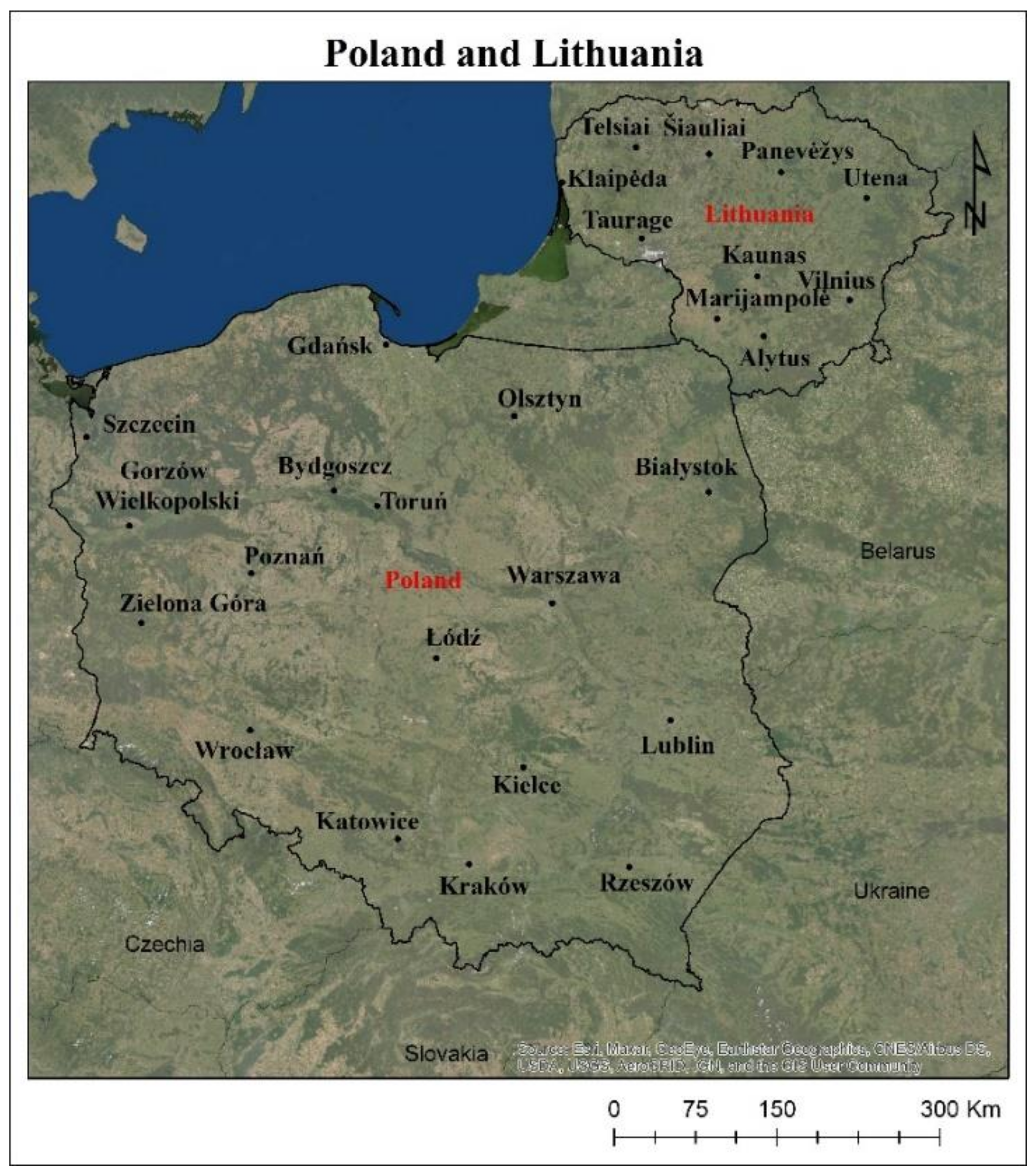
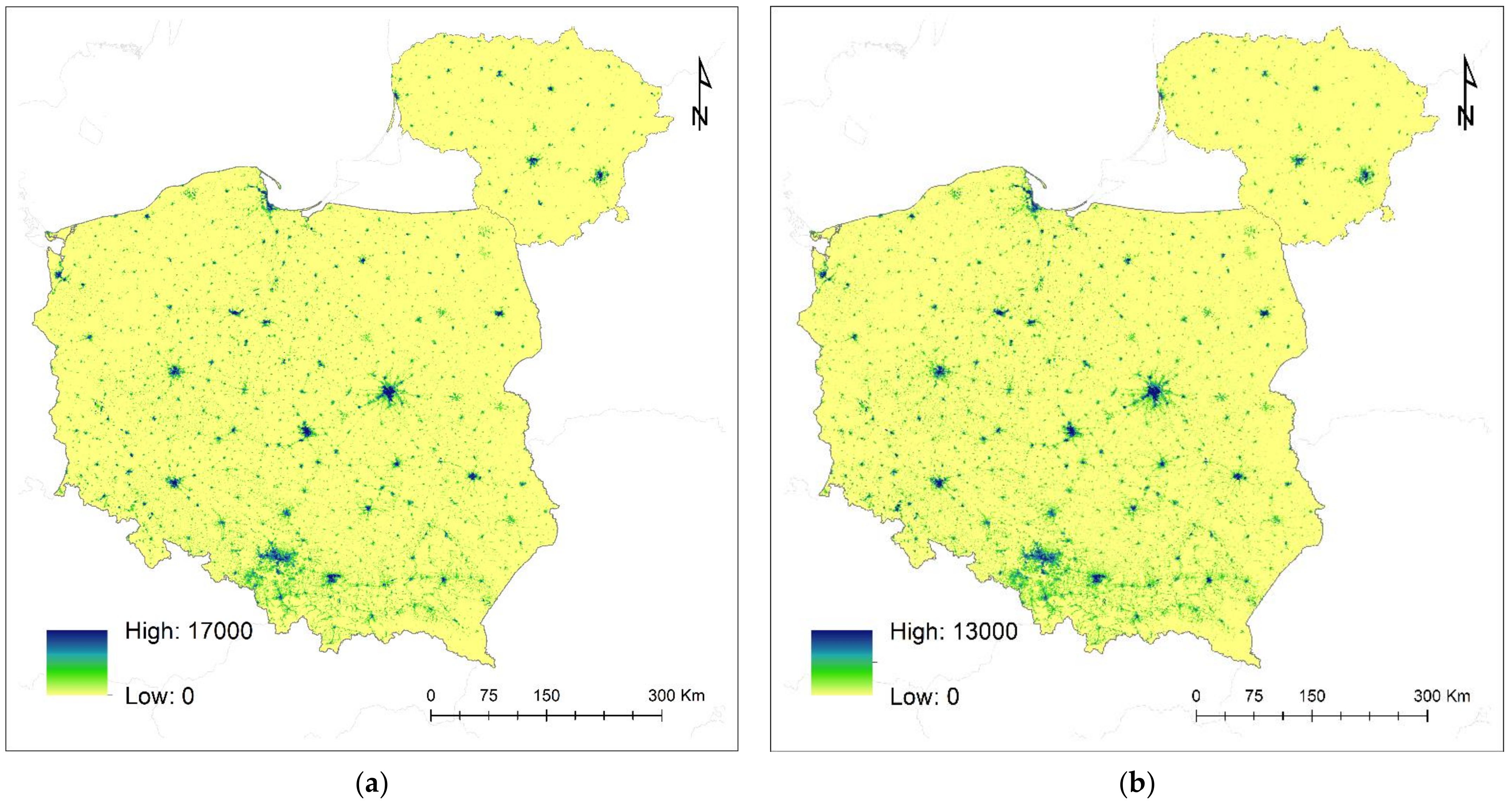
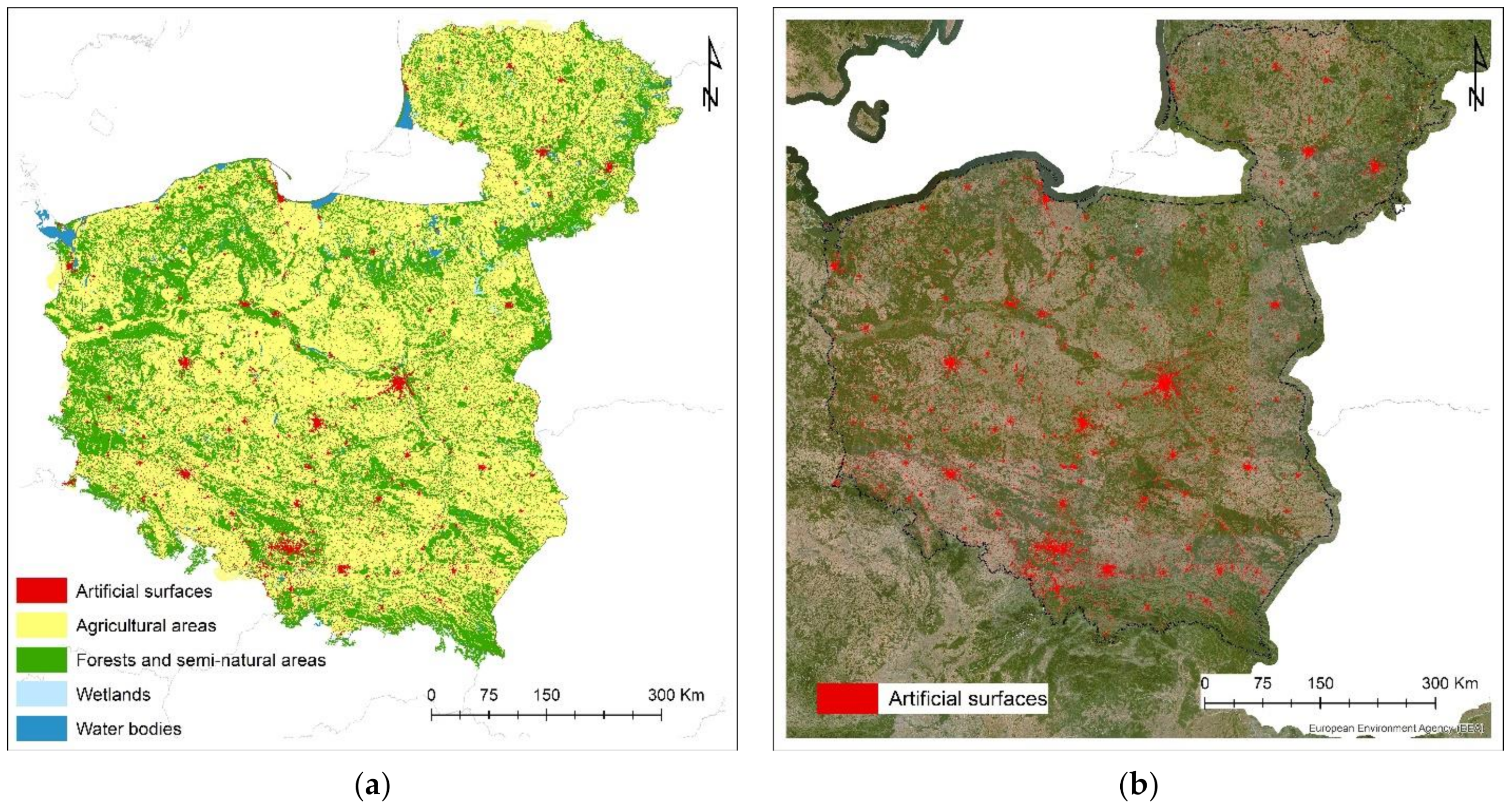
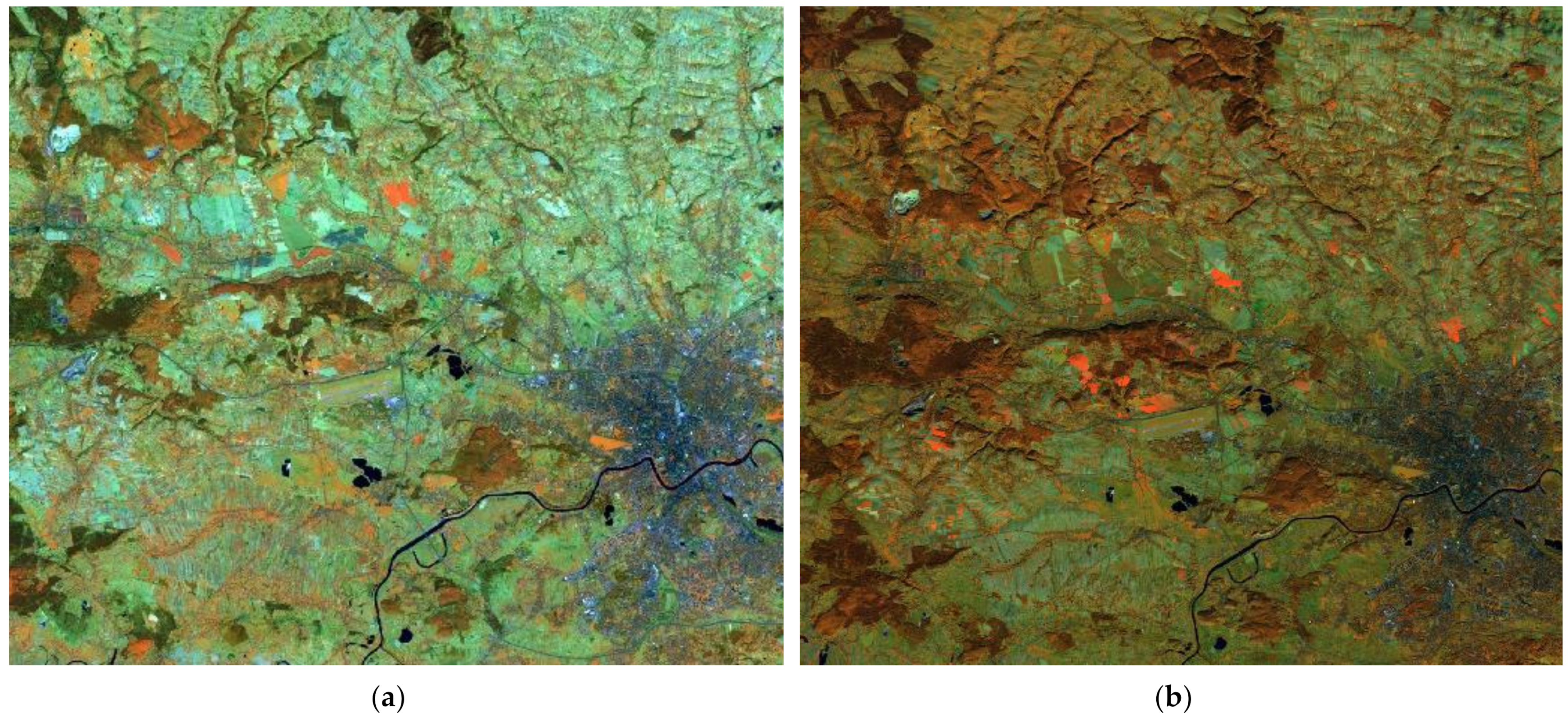


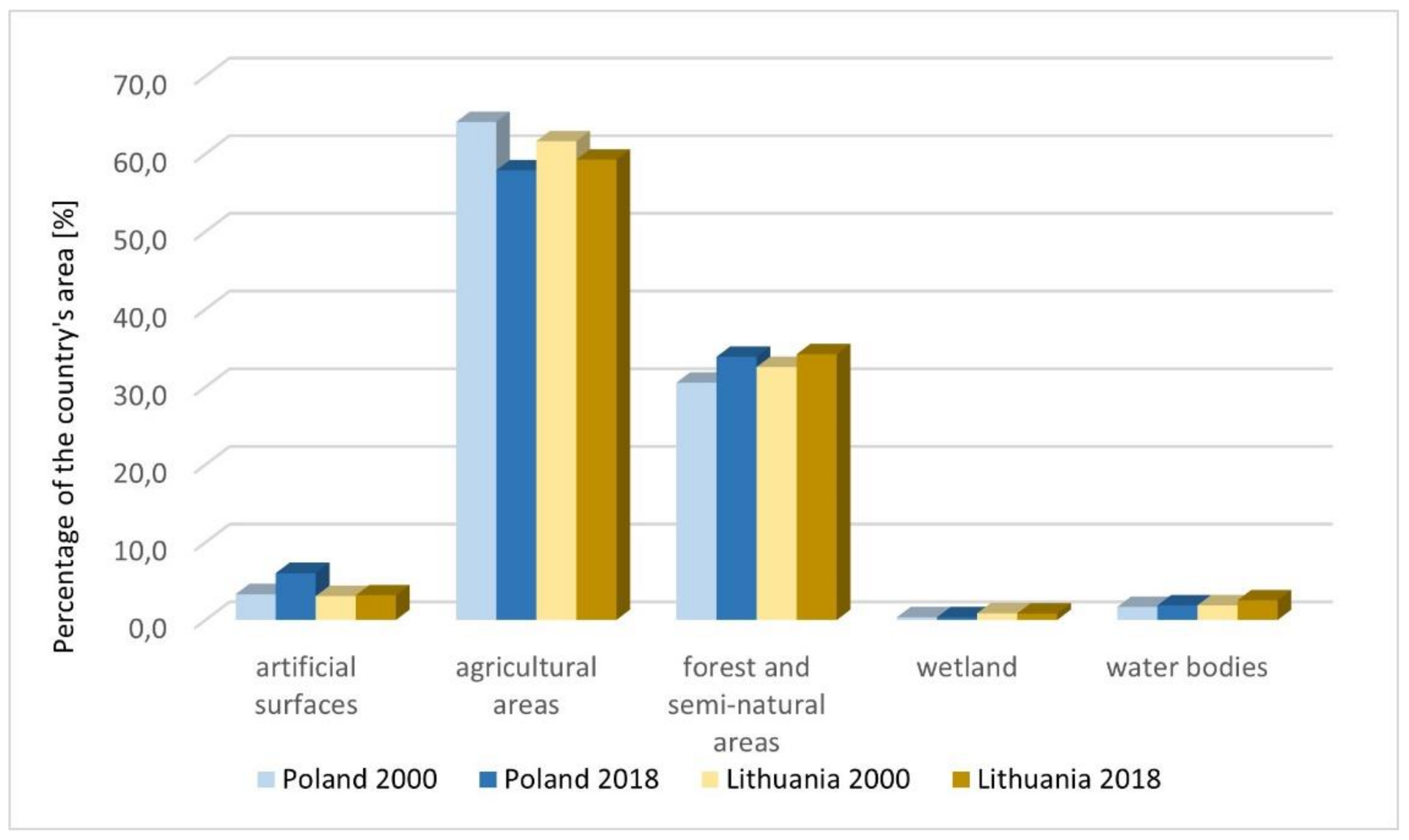




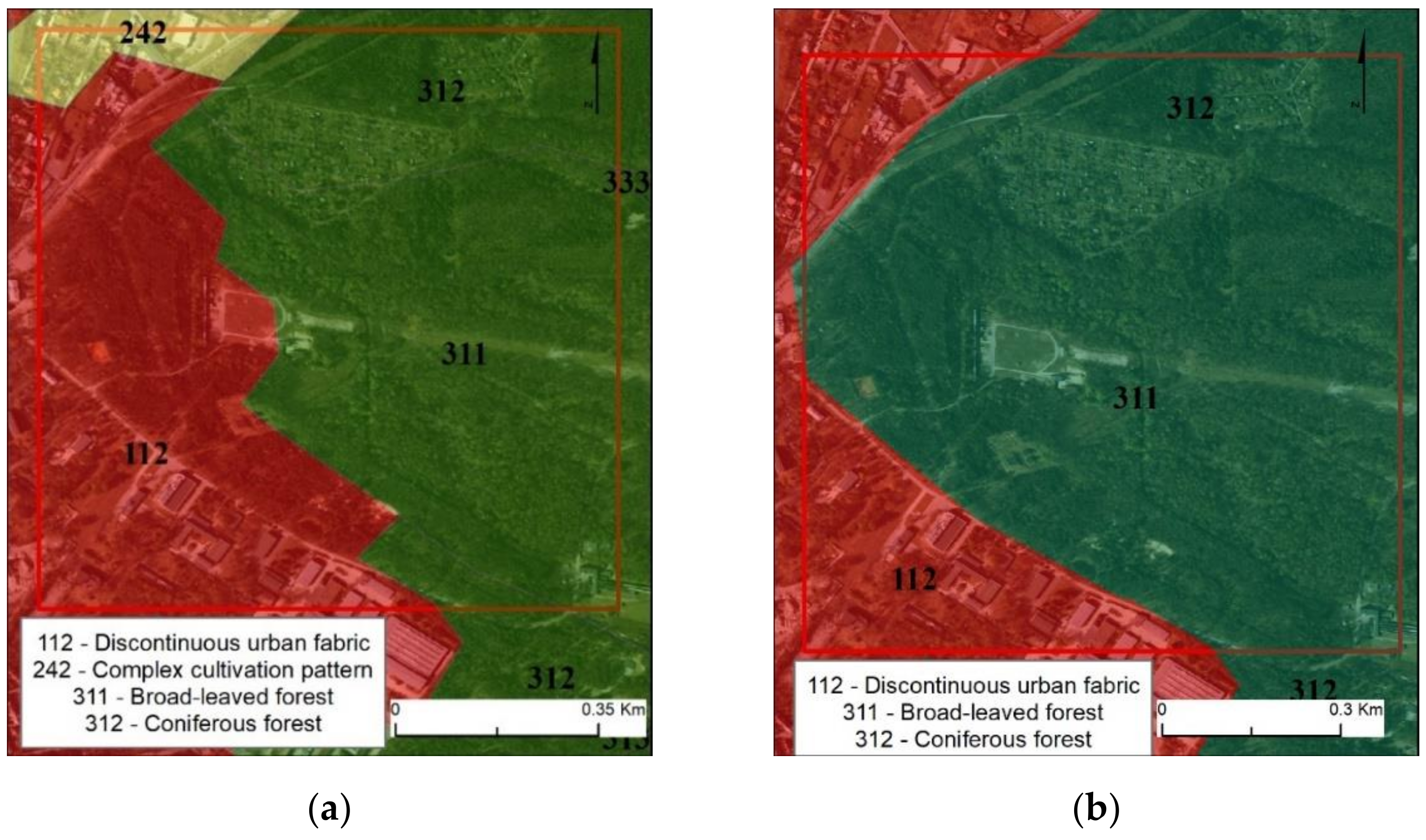
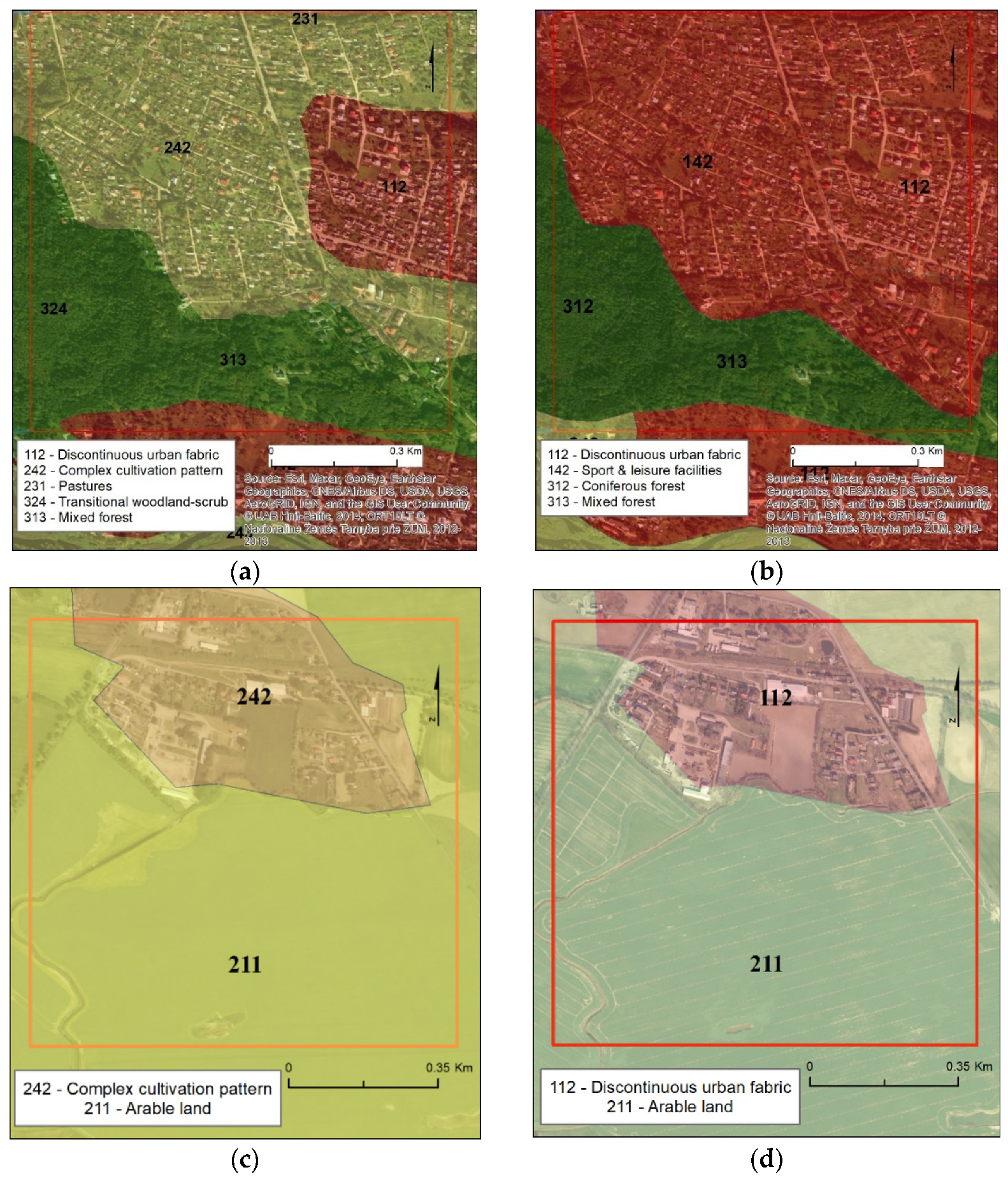
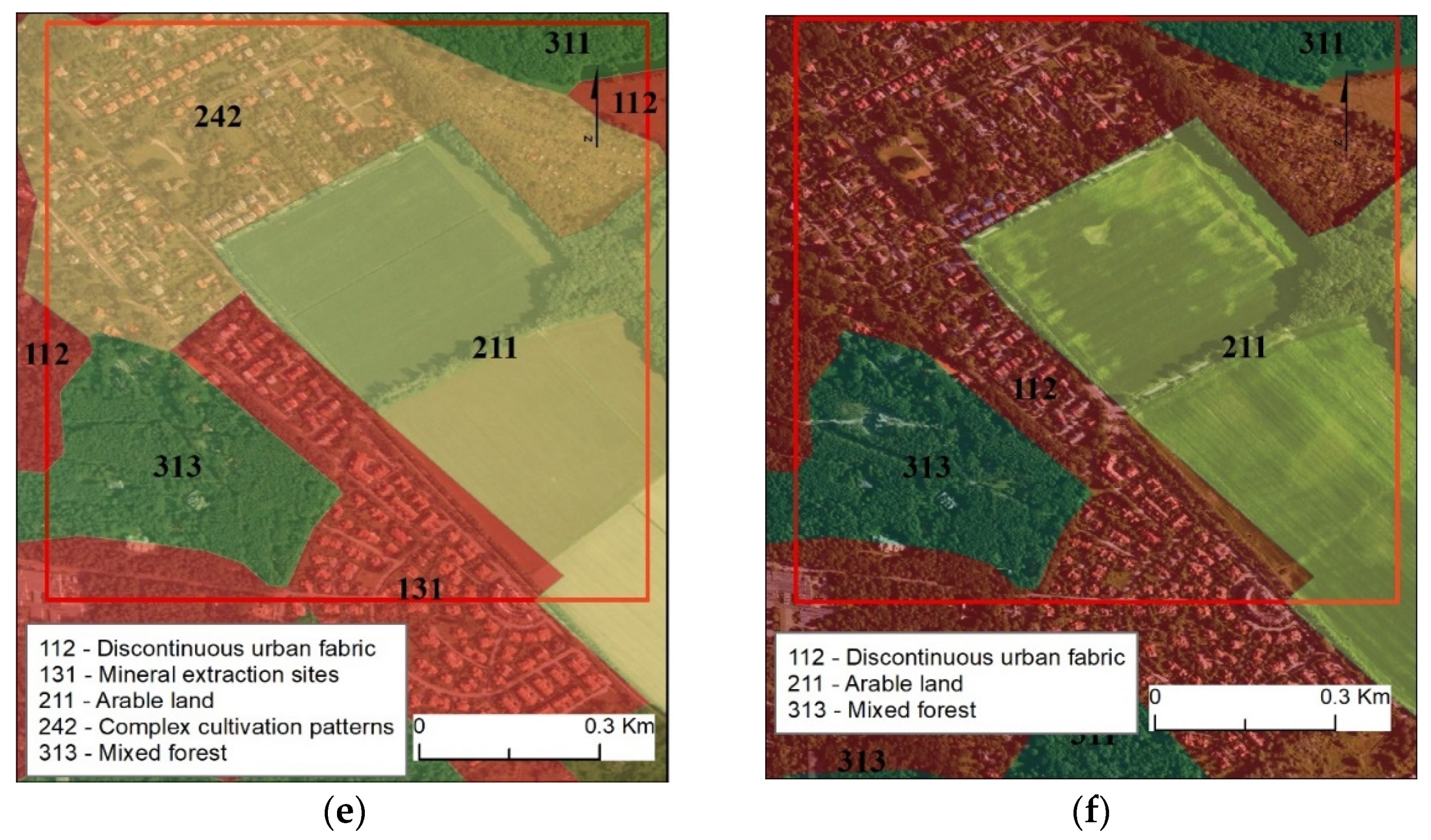
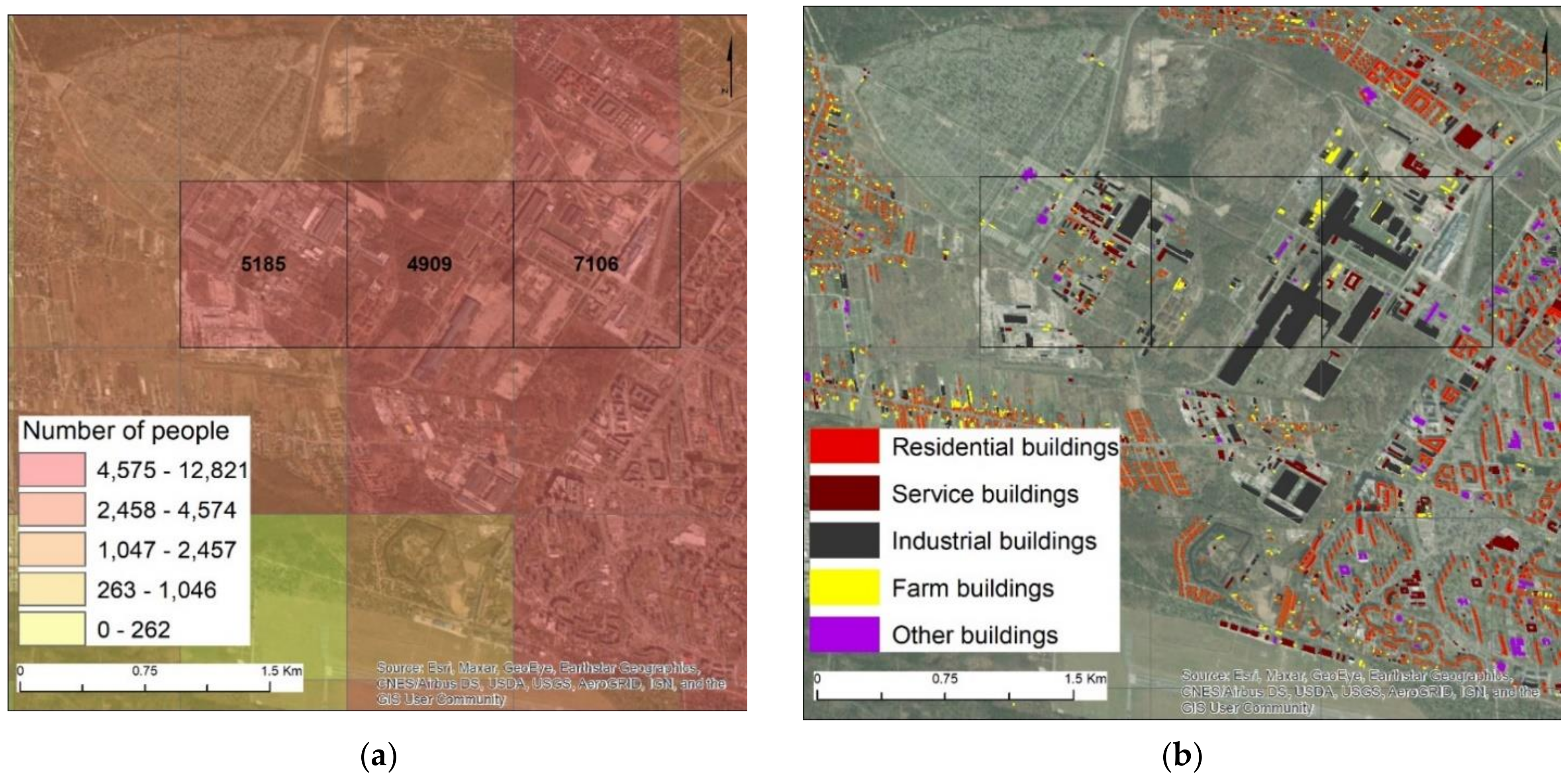
| Data | Poland | Lithuania |
|---|---|---|
| Area | 312,000 km2 | 62,674 km2 |
| Population | 38,034,079 | 2,801,264 |
| Percentage of population in cities | 61.5 | 66.7 |
| Average population density | 124 people/km2 | 55 people/km2 |
| Capital city | Warsaw | Vilnius |
| Population in capital city | 1.764 million | 542,366 |
| The population growth rate | −0.08% | −0.50% |
| Annual migration rate 1 | −1.7 | −9.7 |
| Annual percentage of birth rate in 2015 | −0.16 | −0.20 |
| LCRPGR Classes | PGR | LCR | Development Evaluation | Description |
|---|---|---|---|---|
| LCRPGR < −1 | PGR < 0 | LCR > 0 | Insufficient population growth in relation to the increase in the built-up area | |
| Inefficient land use | ||||
| PGR > 0 | LCR < 0 | Insufficient land per person | ||
| −1 <= LCRPGR < 0 | PGR < 0 | LCR > 0 | Moving away from efficiency | Insufficient population growth in relation to the increase in the built-up area |
| PGR > 0 | LCR < 0 | Insufficient land per person | ||
| LCRPGR = 0 | PGR = 0 | LCR = 0 | ||
| No changes | ||||
| PGR = LCR | ||||
| 0 < LCRPGR <= 1 | PGR < 0 | LCR < 0 | Efficient land use/ moving toward efficiency | A more balanced population decrease in relation to the decrease in the built-up area |
| PGR > 0 | LCR > 0 | More balanced population growth in relation to the increase in the built-up area | ||
| LCRPGR > 1 | PGR < 0 | LCR < 0 | Moving away from efficiency | Insufficient area decreases in relation to the decrease in population |
| PGR > 0 | LCR > 0 | Insufficient area growth in relation to the increase in population growth | ||
| Data | Moran’s I Index | z-Score | |
|---|---|---|---|
| PGR Poland | 0.125183 | 98.988470 | Clustered |
| PGR Lithuania | 0.108139 | 64.601813 | Clustered |
| LCR Poland | 0.422719 | 334.244207 | Clustered |
| LCR Lithuania | 0.347809 | 125.777961 | Clustered |
Publisher’s Note: MDPI stays neutral with regard to jurisdictional claims in published maps and institutional affiliations. |
© 2022 by the authors. Licensee MDPI, Basel, Switzerland. This article is an open access article distributed under the terms and conditions of the Creative Commons Attribution (CC BY) license (https://creativecommons.org/licenses/by/4.0/).
Share and Cite
Calka, B.; Orych, A.; Bielecka, E.; Mozuriunaite, S. The Ratio of the Land Consumption Rate to the Population Growth Rate: A Framework for the Achievement of the Spatiotemporal Pattern in Poland and Lithuania. Remote Sens. 2022, 14, 1074. https://doi.org/10.3390/rs14051074
Calka B, Orych A, Bielecka E, Mozuriunaite S. The Ratio of the Land Consumption Rate to the Population Growth Rate: A Framework for the Achievement of the Spatiotemporal Pattern in Poland and Lithuania. Remote Sensing. 2022; 14(5):1074. https://doi.org/10.3390/rs14051074
Chicago/Turabian StyleCalka, Beata, Agata Orych, Elzbieta Bielecka, and Skirmante Mozuriunaite. 2022. "The Ratio of the Land Consumption Rate to the Population Growth Rate: A Framework for the Achievement of the Spatiotemporal Pattern in Poland and Lithuania" Remote Sensing 14, no. 5: 1074. https://doi.org/10.3390/rs14051074
APA StyleCalka, B., Orych, A., Bielecka, E., & Mozuriunaite, S. (2022). The Ratio of the Land Consumption Rate to the Population Growth Rate: A Framework for the Achievement of the Spatiotemporal Pattern in Poland and Lithuania. Remote Sensing, 14(5), 1074. https://doi.org/10.3390/rs14051074







